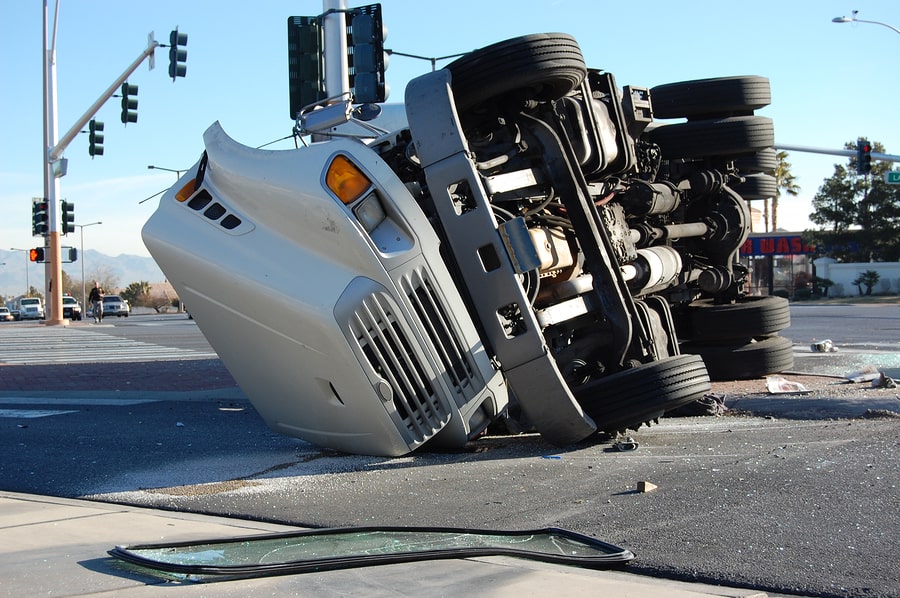
If you ever have driven on an interstate highway or other major roadways, then you have seen hundreds of cars and tractor-trailers, side by side, headed for their various destinations. Especially at night, it can seem as if most of the vehicles on the road are 18-wheelers. Maybe you don’t think about it much, but one thing you have to notice is that those tractor-trailers are a lot bigger than the cars with which they share the road. That’s understandable—those 18-wheelers are carrying all kinds of goods to stores and distribution centers so that you can buy them later.
Your car is designed to carry you and a few passengers—nowhere near as much as the tractor-trailer rigs have to carry. And therein lies at least part of the problem with passenger vehicles sharing the road with 18-wheelers. In situations where large vehicles and small vehicles mingle closely in such large numbers, collisions between the two are inevitable. And physics dictates that when big things hit small things or vice versa, the small things always lose.
When the small things lose such collisions, the injuries to the people inside the smaller vehicles are almost always worse than any suffered by the drivers of the larger vehicles. That means that if you’re in the smaller vehicle and suffer the injuries, you need a Duluth truck accident lawyer.
Tractor-trailers Have the Potential to Inflict Serious Injuries
A look at federal statistics gives you an idea of the disproportionate impact that truck-car accidents have on the occupants of the cars involved. In 2018, the latest year for which complete statistics are available, 4,951 people were killed, and another 151,000 people were injured in traffic accidents involving large trucks in the U.S. In 2018, approximately 531,000 tractor-trailers were involved in traffic accidents that were reported to the police.
The fatality count was nearly a 1 percent increase over 2017, while injuries in traffic accidents involving 18-wheelers were up 2 percent. Of those killed in tractor-trailer crashes in 2018, 71 percent were either drivers or passengers in other vehicles. Of those injured in such crashes, 72 percent were occupants of other vehicles, 26 percent were occupants of tractor-trailers, and 2 percent were not in a vehicle at all, such as pedestrians and bicyclists. Occupants of other vehicles, primarily passenger vehicles, are bearing the brunt of the toll from traffic accidents involving large trucks.
The reasons for that are easy to see. Tractor-trailer rigs are as much as 30 times heavier than passenger cars. Because of that, they take longer to brake and can require as much as 40 percent more distance to come to a stop than most passenger cars require. In poor driving conditions, such as rain, snow, or ice, the difference in stopping distance is even greater. And when a 4,000 -pound passenger car gets tangled up with a 120,000-pound tractor-trailer rig, the vehicle on the losing end of that collision is going to be easy to predict.
Truck Driver Negligence Plays a Role in Many Traffic Accidents
There is a case to be made that, in general, tractor-trailer drivers are better drivers than most non-truck drivers. For starters, truck drivers undergo far more training than most drivers of passenger cars. Some passenger car drivers took a driver’s education course in high school, while others learned to drive with a parent in the passenger seat.
Neither learning method involves the training truckers undergo to obtain their commercial driver’s license.
According to federal statistics, tractor-trailer drivers involved in fatal traffic accidents in 2018 were less likely than passenger car drivers to have any license suspensions or revocations in the past. On the other hand, large-truck drivers involved in fatal accidents in 2018 also had a higher percentage of involvement in previous crashes, at 21.2 percent, than did drivers of any other kinds of vehicles, including motorcyclists (19.8 percent), passenger car drivers (19 percent), and drivers of light trucks (17.5 percent.) Past events are no guarantee of future performance, but there is a reasonable inference that more training does not necessarily rule out negligence.
The very nature of driving trucks feeds the possibility that truck driver negligence will play a role in car-truck accidents. Tractor-trailer drivers are limited in how many hours per day they can drive by federal regulations. They have mandated rest periods and limits in how much they can drive each week, as well.
Even so, the amount of time truck drivers can be on the road each day exceeds the amount of time most people spend at work each day, even if you throw in a brutal commute. Rarely will most people match in one day the amount a tractor-trailer driver is allowed to drive every day. Those long hours spent behind the wheel nearly every day present both causes and opportunities for truck driver negligence that could result in an accident.
For example, government data shows that 13 percent of commercial drivers, including drivers of tractor-trailer rigs as well as bus drivers, were fatigued when they were involved in an accident. Private studies not only back up that statistic but suggest it may dramatically understate the problem, with one study finding that fatigue could factor in as many as 40 percent of accidents involving tractor-trailers.
Driver fatigue can lead to slowed reaction times, poor decision-making, more difficulty in paying attention and remaining vigilant, increased distractibility, and raising the likelihood of driver-performance errors. With the pressures on truck drivers to deliver their loads on time, most end up driving the maximum allowed number of hours per day. While that amount of driving is permitted by regulations, hitting the maximum day after day is a recipe for driver fatigue.
Fatigue is not the only negligent act by which truckers cause accidents. The three major critical events cited in crashes involving tractor-trailers are:
- Drifting into the next lane or off the road onto the shoulder, an act that causes 32 percent of 18-wheeler crashes.
- Losing control of the truck, either because of driving too fast for conditions, equipment failure, shifting cargo, or inclement weather, which together make up 29 percent of truck crashes.
- Colliding with the rear end of the vehicle in front of them, the cause of 22 percent of truck crashes.
Other leading causes of crashes involving 18-wheelers include:
- Speeding. As with all other types of motor vehicles, speeding is a leading cause of accidents for large trucks.
- Improper lane changes. This can include failing to check mirrors or blind spots. While all vehicles have blind spots, and failure to check the blind spots is a major cause of accidents for every class of vehicle, the larger the vehicle, the larger the blind spots. Tractor-trailer rigs have blind spots on both sides of the vehicle, behind the vehicle—often extending as much as 200 feet—and, with some models of semis, directly in front of the vehicle. While truck drivers should check their blind spots as much as possible, other drivers also should try to avoid being in one. In particular, drivers of long-hood trucks cannot see directly in front of their vehicle. Positioning your vehicle right in that spot, too close to the truck, is asking to get rear-ended.
- Driving while using alcohol or drugs. While only 3 percent of the drivers of tractor-trailers involved in fatal accidents in 2018 had blood alcohol levels of .08 or above—the legal limit in most states—the hazard exists. That said, the percentage of large truck drivers who are involved in a crash while using alcohol is much lower than any other category of drivers, including motorcycle riders (25 percent), passenger car drivers (21 percent), and light truck drivers (19 percent). Because trucking is a highly regulated industry, if a driver were to get a drunk-driving conviction, that driver would lose his commercial driver’s license and likely never get it back. Knowing that it would mean losing their livelihood probably is a strong incentive for most truck drivers not to drink and drive, but it obviously doesn’t halt the practice entirely.
A host of other factors can play a role in accidents involving tractor-trailers. Many arise from fairly routine events on the roads and highways. Tractor-trailers are slower to react than a much smaller vehicle, even if the truck driver takes the appropriate actions right away. The inertia and mass of an 18-wheeler make it slower to change directions or to slow or stop. Thus, some common causes may or may not be driver negligence, depending upon the circumstances of individual cases.
Less-common factors contributing to tractor-trailer accidents include:
- Traffic jams or other accidents on the highway. Everyone has been driving along an apparently clear highway at some point, topped a hill or rounded a bend, and encountered a road jammed with stopped or severely slowed vehicles. Reacting quickly to such an unexpected situation is far more difficult for an 18-wheeler than for a smaller vehicle. Accidents can result.
- Prescription drug use. While legal, some prescription drugs have side effects that make driving ill-advised while taking the drug. Some of these drugs are vital to health, and truck-drivers, like most other people, will be willing to take a relatively small risk to continue earning a living. The same can apply to the use of over-the-counter non-prescription drugs. The use of such non-prescription drugs is perfectly legal, but it can degrade a driver’s ability to pay attention or react quickly.
- Attempting to stop for a signal. Rapid braking can result in a tractor-trailer rig jack-knifing. Failure to stop in time can result in rear-ending a vehicle already stopped at the traffic signal.
- Road conditions, such as rain, snow, ice, and fog can play a role in truck accidents, just as for any other kind of motor vehicle. Driving too fast for conditions can be a factor in such accidents.
- Driving on an unfamiliar road or highway. With the driver not knowing what to expect on an unfamiliar road or highway, sudden curves or stops can easily lead to an accident rooted in the slower reaction times of tractor-trailers, speeding, or driving too fast for conditions.
Accidents Involving Tractor-Trailers Often Result in Severe Injuries
The vast majority of deaths and injuries in accidents involving tractor-trailers and passenger cars occur among the occupants of the passenger cars—more than 70 percent of all fatalities and injuries in such accidents. Because tractor-trailer rigs have much higher ground clearance than do most passenger vehicles, many accidents result in what is known as an override. A car striking an 18-wheeler from behind often drives under the rear of the trailer.
And when the collision involves the front end of the 18-wheeler, overrides occur in 72 percent of accidents. The truck literally drives over the passenger car, usually resulting in death or severe injuries for the occupant of the passenger car.
The size advantage tractor-trailers have over passenger vehicles contributes to the severity of injuries to occupants of passenger vehicles. In part because of the common occurrence of overrides, and the accompanying crushing of the passenger vehicle, certain injuries commonly take place in accidents involving 18-wheelers and passenger cars.
These include:
- Traumatic brain injuries: The leading cause of TBI is traffic accidents, including accidents involving 18-wheelers. Severe TBI can result in life-long disabilities. Such injuries can require extensive care, possibly life-long, and result in considerable medical expenses.
- Spinal cord injuries: Traffic accidents are the top cause of spinal cord injuries, as well, leading to 38 percent of all spinal cord injuries, commonly called SCI. Like TBI, spinal cord injuries can be life-long and require months or years of expensive care and therapy.
- Broken bones: A common injury in all traffic accidents, broken bones are extremely frequent in accidents involving 18-wheelers because of the extraordinarily violent forces involved. These injuries can be severe, especially in compound fractures, where the broken bone pushes out through the skin. These can take months to year and months or years of therapy, in addition to being extremely painful.
Given the potential for trucker negligence in accidents, if you are in an accident with an 18-wheeler, there is a good chance that you have a claim. To find out whether you are entitled to compensation, contact an attorney in your area today.














